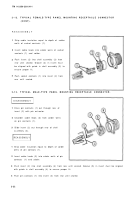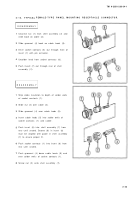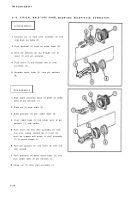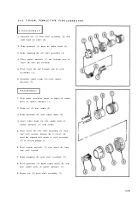TM-9-2350-238-34-1 - Page 43 of 292
warning
TM 9-2350-238-34-1
2-25. NONSKID AREAS.
Nonslip paint (item 9, appx B) will be used to coat deck areas wher e
personnel walk. The seven areas (1 thru 7) to be coated with nonslip paint are shown in the figure
on page 2-30.
2-26. TOUCHUP AND RECOATING .
Unusable CARC mixtures are considered hazardous waste and will require disposal i n
accordance with Federal, state, DOD, DA, and local installation waste regulations.
Consult the installation environmental office for proper disposal guidance. Mixe d
CARC is extremely flammable—use only in well-ventilated areas and keep away fro m
open flames, heat, sparks, and other ignition sources.
Ž
•
•
•
•
•
•
•
For brush/roller painting in confined spaces, an airline respirator is required, un-
less an air sampling shows exposure to be below standards. If the air sampling
is below standards, either chemical cartridge or airline respirators are required.
Spot painters applying CARC paint by brush or roller must wear clothing and
gloves affording full coverage .
Do not use water, alcohol, or amine-based solvents to thin or remove CARC
paints. Use of these solvents with CARC paints can produce chemical reactions
resulting in nausea, disease, burns, or severe illness to personnel.
Do not use paint solvents to remove paint/coating from your skin.
Mix paint/coating in a well-ventilated mixing room or spraying area away from
open flames. Personnel mixing paint/coating should wear eye protection .
Use paint/coating with adequate ventilation .
Personnel grinding or sanding on painted equipment should use high efficiency
air purifying respirators.
Do not weld or cut CARC-coated metal because substances causing skin or
respiratory irritation may be released. Before applying heat, sand or grind paint
down to bare metal on area four inches to either side of the area you plan to
weld or cut.
When touching up damaged areas, the procedure should be as similar to the original method of
finishing as possible; a clean surface is imperative. Where general disintegration of the surface is
evident, or the under surface is corroded, the coating must be stripped clean from the part.
Corrosion must be removed or neutralized by mechanical or chemical treatment, or both, and the
surface metal must be pretreated, primed, and then top coated.
2-27. RESTENCILING VEHICLE MARKINGS.
Refer to TM 9-2350-238-20-1 .
2-31
Back to Top




















